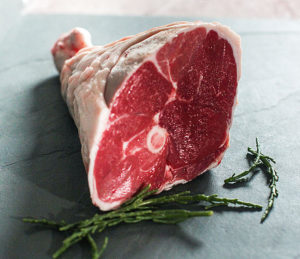 Spring has definitely arrived in the UK and that means that spring lamb is now available to enjoy. When buying your spring lamb, you should look for firm, slightly pink meat with a velvety texture; as the meat ages it becomes darker in colour. You should also look for cuts that show PGI status, which shows the regional origin of the meat.
Spring has definitely arrived in the UK and that means that spring lamb is now available to enjoy. When buying your spring lamb, you should look for firm, slightly pink meat with a velvety texture; as the meat ages it becomes darker in colour. You should also look for cuts that show PGI status, which shows the regional origin of the meat.
Like other meat, your spring lamb should be stored on a low shelf in the refrigerator, away from cooked foods and food that is to be eaten raw. Lamb also freezes well. Small cuts can be stored for up to three months and larger cuts for up to six months.
Preparing spring lamb
Lamb shoulders and legs are tasty when cooked on and off the bone as the collagen and marrow from the bone are released when cooking, tenderising and flavouring the meat; though joints which are boned before roasting are much easier to carve. Lamb can also be butterflied for barbecuing or if you fancy a rack of spring lamb, you just need to remove the fat and back bone during preparation.
There are of course many other cuts of spring lamb such as steaks, chops and even diced lamb for stews and casseroles which can all be prepared in different ways according to taste. Lamb is also a great choice for barbecues and makes delicious, tasty burgers and kebabs.
Cooking spring lamb
In general, we recommend that you roast a leg or loin of lamb; grill middle loin or loin shops; braise the shoulder, neck chops and shanks; and mince the shoulder, loin or leg to make lamb burgers.
To be more specific, we have selected some of our most popular cuts with tips on how to prepare and cook them:
- Leg of lamb: everyone’s favourite spring Sunday roasting joint, lamb leg is popular due to it’s dark, melt-in-the-mouth meat and meat-to-bone ratio, making this one easy to carve at the dinner table. A leg is best cooked whole and you can keep things simple by slowly roasting the leg whole, studded with garlic and rosemary, for dark, tender meat.
- Lamb leg steaks: if you’re stuck for time and looking for a quicker supper, lamb leg steaks are a wonderful lean cut, each with a portion of bone in to keep the meat wonderfully juicy when cooked. Griddle or pan fry for 3–5 minutes on each side for medium-rare meat, or longer if you like it well done.
- Lamb chops: unlike the boneless steaks, lamb chops contain bone so need slightly longer cooking. Rub with oil and fresh chopped herbs like mint and parsley then oven bake until crisp and golden brown for about 30–45 minutes, depending on the size of your chops.
- Loin of lamb: taken from the top of the back, the loin is a prized cut of lamb due to the super tender meat. It’s an ideal cut for roasting, however, as it doesn’t have a layer of fat for protection, care must be taken not to overcook.
- Rack of lamb: taken from the lamb ribs, the rack is very popular as a great, impressive all-rounder, that’s super quick to cook and easy to achieve perfectly crisp skin and tender, melt-in-the-mouth flesh. The cutlets are individual rib steaks taken from the rack and look beautiful on the plate.
- Breast of lamb: Lamb breast is a value cut that is often underused as it has quite a lot of fat and can be tough if cooked incorrectly. Treat as you would pork belly and you’re away to go; and he layer of fat brings oodles of flavour and helps to tenderise the meat as it cooks.
Hugh Phillips Gower Butcher
The spring lamb we sell at our stall in Swansea Market and from our online shop, www.bestonlinebutcher.co.uk, is all locally sourced, Welsh lamb with PGI status.
Lamb is undoubtedly one of our most popular choices, particularly in spring when the new season’s spring lamb is readily available.
To find out more, check out the section on our website dedicated to our lamb products which includes all of the cuts listed above plus many more… including some delicious BBQ options.


